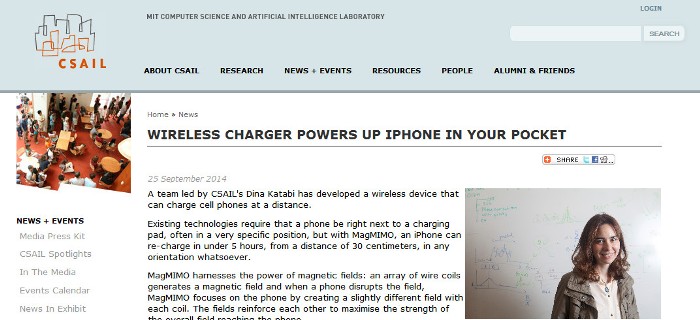MIT’s MagMIMO Is a Wireless Charging Tech Meant to Have a Wi-Fi-Like Range
A team at MIT led by Dina Katabi of the MIT Computer Science and Artificial Intelligence Laboratory (CSAIL) has developed a new wireless charging tech that aims to increase wireless charging range into something comparable to that of a Wi-Fi router’s. Called MagMIMO, this long-range wireless charging technology is intended to make charging more convenient for everyone as it eliminates the need for charging plates and close proximity to the charger. Once perfected, it should be able to rival the 15-feet wireless charging range of the technology created by the Korea Advanced Institute of Technology (KAIST).
Wireless changing has been around for quite some time but the short range needed to enable charging is not making it that practically appealing. With MagMIMO, the charging range has been demonstrated to go over 30 centimeters or around a foot. This is dozens of times longer than the approximately 1-centimeter range of the Qi standard, arguably the most popular wireless charging standard being employed at present. The upcoming 1.2 version of the Qi standard is expected to increase the range to 4.5 centimeters, still short compared to MIT’s MagMIMO.
Specs
No details on the charging capacity of the device has been released but the MagMIMO prototype produced at MIT is said to be capable of fully charging the 1420 mAh battery of an iPhone 4S for a period of less than 5 hours. That means around 284 mAh of replenished battery power for every hour. It can also charge a device regardless of its position or orientation as long as it is within the 30 centimeter prescribed range. Yes, 30 centimeters is not really that long to be called long-range; that’s why Katabi and her team are currently working on boosting the effective range of this technology. The goal is to make it close to the range of Wi-Fi routers, to offer a truly convenient wireless charging experience.
![By Dsimic (Own work) [CC-BY-SA-3.0 (http://creativecommons.org/licenses/by-sa/3.0)], via Wikimedia Commons](https://techtheday.com/wp-content/uploads/2014/10/Qi-wireless-charger.jpg)
By Dsimic (Own work) [CC-BY-SA-3.0 (http://creativecommons.org/licenses/by-sa/3.0)], via Wikimedia Commons
How Does It Work
MagMIMO works by harnessing the power of magnetic fields. It is basically inspired by the way advanced Wi-Fi routers work. It detects a device and boosts the “signal” going to the device. The “signal” here, however, is in the form of magnetic waves instead of radio waves. The MagMIMO device comes with an array of wire coils that generate a magnetic field. When a device disrupts this magnetic field, MagMIMO focuses its transmissions on the device by generating a slightly different field with each coil. The magnetic fields here reinforce each other thereby enhancing the strength of the overall field that reaches the phone.
Longer Range, Same Power Consumption
One significant attribute that makes MagMIMO extra special is its power efficiency. It has a longer range but without using excessive amounts of power. Katabi claims that “MagMIMO consumes as much power as existing solutions.” The research team at MIT hopes to maintain the power consumption levels even as longer ranges are achieved.
Additionally, MagMIMO comes with the advantage of not causing a heating effect on human tissue. Unlike strongly focused Wi-Fi, the focused magnetic fields of MagMIMO don’t produce adverse effects especially on the human skin. This makes it suitable for wireless charging even when the device is inside a user’s pocket.
Applications
Long-range wireless charging is highly advantageous in replenishing the batteries of small devices, especially wearables. While charging time could be quite slow, it eliminates the need to regularly take off a device to be attached to a charger or put on a charging dock or plate. This means that devices can be charged even as they are worn or used. This is particularly beneficial for smart watches or smart bands that can’t be equipped with large batteries since they have to small and slim to be comfortably wearable.
![By NJo (Own work) [CC-BY-SA-3.0 (http://creativecommons.org/licenses/by-sa/3.0)], via Wikimedia Commons](https://techtheday.com/wp-content/uploads/2014/04/wireless-charging.jpg)
By NJo (Own work) [CC-BY-SA-3.0 (http://creativecommons.org/licenses/by-sa/3.0)], via Wikimedia Commons
Availability
The MagMIMO prototype demonstrated at MIT is still far from becoming a final product. Hence, commercial availability is still uncertain. The demonstration even had the charging coils outside of the device being charged, not integrated inside the device’s body. Also, the research team behind is still trying find ways to increase the charging range to make it a truly convenient wireless charging solution.
Technologies like this will doubtlessly benefit consumers in the future. It’s just important to make sure that the technology is safe to use. Aside from the range boosting efforts, tests on the reactions of the human body to the magnetic fields created will also be essential.
